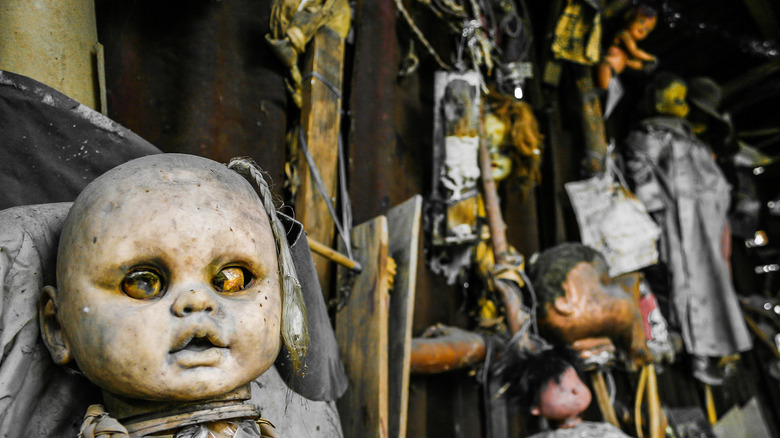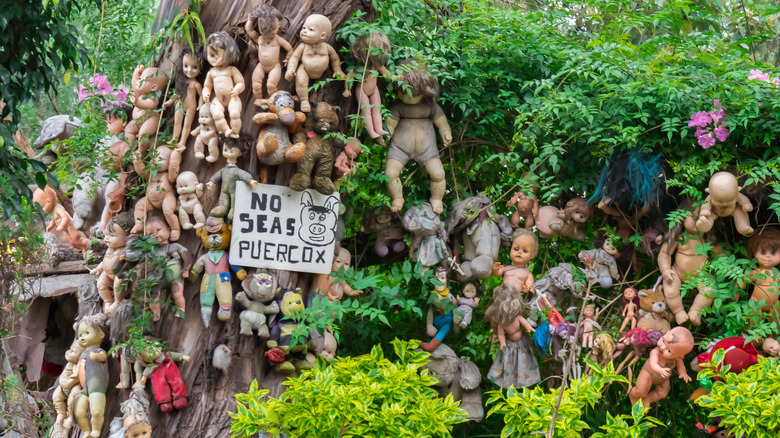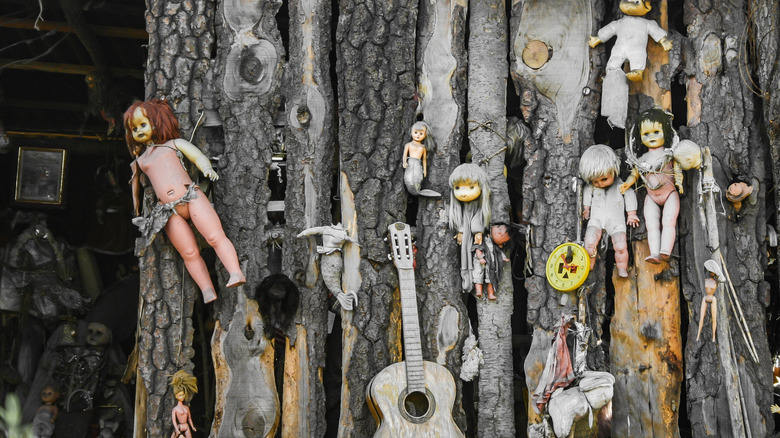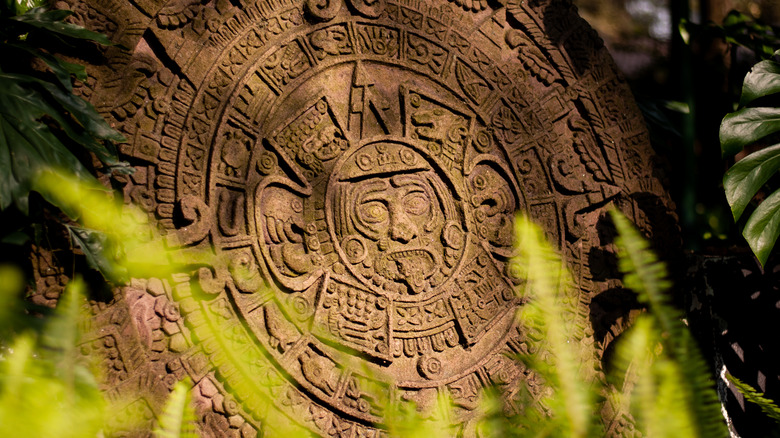The Truth About The Island Of The Dead Dolls
At this point we've all seen that Annabelle doll from those freaky "Conjuring" movies, right? And Jigsaw's tricycle-riding puppet from the "Saw" franchise? And that classic murder doll Chucky from the "Child's Play" movies? Yep, popular culture dictates that dolls are nothing more than nightmare fuel, rather than quaint children's toys from a time before tappy-tap iPad games. The glassy, dead eyes staring from an unmoving ceramic head; the doll's body, a poor fabrication of life, propped atop a child's pillow like a floppy corpse posing for a portrait — if any earthly item seems likely to be cursed, or to bestow a curse, it's a doll.
So how about an island full of them? Not just whole dolls, but little hacked pieces. We're talking decrepit, mutilated, decapitated, eyeless, stained with dirt, and strung up in trees in a boggy marsh filled with abandoned, ramshackle shacks, as Atlas Obscura depicts. Did we mention that the dolls are dead? (Not that they were ever alive, right?) Welcome to Isla de las Muñecas, or "Island of the Dolls," in the canals of Xochimilco, about 14 miles south of Mexico City. Have you ever wondered what a serial killer's warm and fuzzy place looks like? Well, just hop on a colorful trajiñera (gondola) and pay a visit, as Trip Advisor helpfully outlines.
Naturally, this island of the tormented and damned didn't just pop up out of nowhere. There's a ghost story attached to it, and a dude who built it.
Appeasing a young girl's spirit
The tale of Isla de las Muñecas starts about 50 years ago with a local man named Julián Santana Barrera, as Atlas Obscura explains. Barrera, it seems, had abandoned his wife and child to go live alone and isolated within the canals of Teshuilo Lake in the Xochimilco canals south of Mexico City. While we have no idea why, we do know exactly where he went. As Google shows us, Barrera's former hermetic retreat now nestles within Xochimilco Ecological Park, about a stone's throw from a major thoroughfare.
As the (likely apocryphal) story goes, one day Barrera found a young girl's body drowned and floating in the nearby river, with a doll floating behind her. Barrera retrieved the doll from the water — no mention on whether he did the same for the girl — and hung it up on his property to honor the girl's spirit. Legend says he kept hearing the girl's spirit speaking to him, and to appease her, collected dolls, doll limbs, doll clothing, and the like, and hung them all up on his property. Insider claims that he also believed that each doll was possessed by the spirit of a deceased girl. He didn't clean, wash, or alter the dolls in any way, and now they hang, dirty and decaying, ruined by time and the elements.
Barrera's family has gone on record to say that Barrera made the whole drowned girl thing up, as Insider says. We'll never know, though, because Barrera himself reportedly drowned in 2001 near the spot where he found the girl's body, per Unusual Places.
Come play with us, traveler
Naturally, tales of drowned girls, hauntings, and mutilated plastic corpses nailed into planks of wood has caught the attention of the public. At present, Isla de las Muñecas is just another part of Mexico's tourism industry, especially on the local side, as Trip Advisor depicts. Barrera's unhinged obsession has become others' curiosity, and his desire for solitude has ironically called traveler after traveler to his formerly isolated, swampy refuge.
One thing to bear in mind, as this travelogue video by Alexander Travelbum (presumably not his real last name) on YouTube explains, is all the copycat islands that have cropped up nearby. Human nature being what it is, it looks like some locals have taken to forging their own dead doll islands to snag unwary travelers. The easiest way to spot fakes? They're right next to the canal-side, while the original takes over an hour to reach. Those interested in visiting Isla de las Muñecas can ferry to the island using a trajiñera, a brightly-painted, multi-colored gondola. It costs about 50 pesos ($2.50) to take the ferry, go inside, take some pictures of soiled and fragmented plastic corpses, and possibly curse your immortal soul for all eternity.
Some reviews on Trip Advisor are less than enthusiastic, calling it "a nice little trip [if] you want a boat ride," and otherwise "pretty boring." Others mention being harassed by hawkers, and another describes "two toilets with the least privacy in the world."
Aztec history older than dolls
Another, deeper layer to the story of Isla de las Muñecas relates back to the Aztecs. Mexico was home to the Aztec Empire from about 1345 to 1521 CE, although its people settled in the area as early as the 1100 CE, as the World History Encyclopedia says. Its capital, Tenochtitlan, was located right at present-day Mexico City, and was razed by Spanish conquistador Hernán Cortés in 1521.
As the New York Post discusses, however, Xochimilco Ecological Park — which houses Isla de las Muñecas — may have been used as a hiding spot for Aztec refugees. One local resident, Gerardo Ibarra, says, "A lot of these people were women and children hiding from the conquistadores. And many women killed themselves rather than be caught and raped" by the Spanish. Bear in mind that Ibarra is the founder of a travel company and has a vested interest in hyping up the area. His kind of unverifiable statement should be taken with a grain of salt no matter how well it fits with a grander, dramatic narrative.
At present, it's true that Xochimilco is a UNESCO World Heritage Site. Its pre-Spanish, pre-colonial roots are still visible in the environment, particularly the "chinampas," or "floating gardens," of Xochimilco Ecological Park. The park itself is considered a terraformed, "half-natural, half-artificial" landscape. The area has some real history to it aside from much more recent, spooky tales of spirits and obsessive doll collecting.



